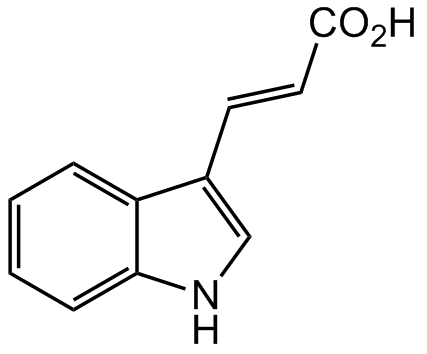trans-Indole-3-acrylic acid
| Code | Size | Price |
|---|
| AG-CR1-3677-M250 | 250 mg | £40.00 |
Quantity:
| AG-CR1-3677-G001 | 1 g | £65.00 |
Quantity:
Prices exclude any Taxes / VAT
Overview
Regulatory Status: RUO
Shipping:
Ambient
Storage:
4°C
Images
Documents
Further Information
Alternate Names/Synonyms:
IAcrA; trans-3-Indoleacrylic acid; trans-beta-Indoleacrylic acid; (E)-3-(1H-Indol-3-yl)acrylic acid; NSC29428; NSC137806; BRN0006317
Appearance:
Off-white solid.
CAS:
29953-71-7
EClass:
32160000
Form (Short):
liquid
GHS Symbol:
GHS07
Handling Advice:
Protect from moisture.
Hazards:
H315, H319, H335
InChi:
InChI=1S/C11H9NO2/c13-11(14)6-5-8-7-12-10-4-2-1-3-9(8)10/h1-7,12H,(H,13,14)/b6-5+
InChiKey:
PLVPPLCLBIEYEA-AATRIKPKSA-N
Long Description:
Chemical. CAS: 29953-71-7. Formula: C11H9NO2. MW: 187.2. Synthetic. Inflammation suppressor. Tryptophan metabolite produced by human microbiota (intestinal commensale Peptostreptococcus sp). Involved in keeping the intestinal barrier intact and works as anti-inflammatory molecule. Patients with Inflammatory bowel Disease (IBD) have an altered microbiota, with less Peptostreptococcus sp., and therefore reduced production of trans-indole-3-acrylic acid. Chromophoric L-Trp analog used to probe the allosteric properties of the internal aldimine of tryptophan synthas. Also shown to be a moderate inhibitor of tryptophan synthase, trypothan-2,3-dioxygenase, indoleamine-2,3-dioxygenase, L-dopachrome isomerase and xanthine oxidase. Reagent used as a matrix for MALDI-TOF mass spectroscopy in order to characterize and analyze polyphenols and synthetic polymers. Used as heterocyclic building block or intermediate for the synthesis of indolyl acrylamide-derived inhibitors, pharmaceuticals or agrochemicals.
MDL:
MFCD00005633
Molecular Formula:
C11H9NO2
Molecular Weight:
187.2
Other data:
Note: Warming and sonication may be required when dissolving the compound in the solvent of choice.
Package Type:
Plastic Vial
Precautions:
P280, P302, P352, P304, P340, P305, P351, P338, P332, P337, P313, P405
Product Description:
Inflammation suppressor. Tryptophan metabolite produced by human microbiota (intestinal commensale Peptostreptococcus sp.). Involved in keeping the intestinal barrier intact and works as anti-inflammatory molecule. Patients with Inflammatory Bowel Disease (IBD) have an altered microbiota, with less Peptostreptococcus sp. and therefore reduced production of trans-indole-3-acrylic acid. Chromophoric L-Trp analog used to probe the allosteric properties of the internal aldimine of tryptophan synthase. Also shown to be a moderate inhibitor of tryptophan synthase, trypothan-2,3-dioxygenase (TDO), indoleamine-2,3-dioxygenase (IDO), L-dopachrome isomerase and xanthine oxidase. Reagent used as a matrix for MALDI-TOF mass spectroscopy in order to characterize and analyze polyphenols and synthetic polymers. Used as heterocyclic building block or intermediate for the synthesis of indolyl acrylamide-derived inhibitors, pharmaceuticals or agrochemicals.
Purity:
>98%
Signal word:
Warning
SMILES:
O=C(/C=C/C1=CNC2=CC=CC=C21)O
Solubility Chemicals:
Soluble in DMSO or ethanol. Slightly soluble in water.
Transportation:
Non-hazardous
UNSPSC Category:
Biochemical Reagents
UNSPSC Number:
12352200
Use & Stability:
Stable for at least 2 years after receipt when stored at +4°C.
References
Inhibition of tryptophan synthetase by indoleacrylic acid: W.H. Matchett; J. Bacteriol. 110, 146 (1972) | Stereospecificity of hepatic L-tryptophan 2,3-dioxygenase: Y. Watanabe, et al.; Biochem. J. 189, 393 (1980) | Inhibition of indoleamine 2,3-dioxygenase and tryptophan 2,3-dioxygenase by beta-carboline and indole derivatives: N. Eguchi; Arch. Biochem. Biophys. 232, 602 (1984) | The structural basis for the interaction between L-tryptophan and the Escherichia coli trp aporepressor: R.Q. Marmorstein, et al.; J. Biol. Chem. 262, 4922 (1987) | Interaction of Indoleacrylic Acid with Trp aporepressor from Escherichia coli: D. Hu & M.R. Eftink; Arch. Biochem. Biophys. 305, 588 (1993) | Photosensizied inactivation of infectious DNA by urocanic acid, indoleacrylic acid and rhodiuk complexes: T. Mohammad, et al.; Photochem. Photobiol. 59, 189 (1994) | Desorption behavior and distributions of fluorinated polymers in MALDI and electrospray ionization mass spectrometry: L. Latourte, et al.; Anal. Chem. 69, 2742 (1997) | Substrate specificity for isomerase activity of macrophage migration inhibitory factor and its inhibition by indole derivatives: M. Suzuki, et al.; J. Biochem. 122, 1040 (1997) | Where does indolylacrylic acid come from?: E. Marklova; Amino Acids 17, 401 (1999) | Novel allosteric effectors of the tryptophan synthase K2L2 complex identifed by computer-assisted molecular modelling: A. Marabotti, et al.; Biochim. Biophys. Acta 1476, 287 (2000) | MALDI-TOF mass spectrometry of oligomeric food polyphenols: J.D. Reed, et al.; Phytochemistry 66, 2248 (2005) | Allosteric regulation of tryptophan synthase channeling: the internal aldimine probed by trans-3-indole-3'-acrylate binding: P. Casino, et al.; Biochemistry 46, 7728 (2007) | Structural insight into the inhibition of human kynurenine aminotransferase I/glutamine transaminase KII: Q. Han, et al.; J. Med. Chem. 52, 2786 (2009) | Tryptophan 2,3-dioxygenase (TDO) inhibitors. 3-(2-(pyridyl)ethenyl)indoles as potential anticancer immunomodulators: E. Dolusic, et al.; J. Med. Chem. 54, 5320 (2011) | Discovery of indolyl acrylamide derivatives as human diacylglycerol acyltransferase-2 selective inhibitors: K. Lee, et al.; Org. Biomol. Chem. 11, 849 (2013) | Synthesis, biological evaluation and molecular docking studies of trans-indole-3-acrylamide derivatives, a new class of tubulin polymerization inhibitors: S.N. Baytas, et al.; Bioorg. Med. Chem. 22, 3096 (2014) | Indoleacrylic acid produced by commensal Peptostreptococcus species suppresses inflammation: M. Wlodarska, et al.; Cell Host & Microbe 22, 25 (2017)



